Migrating from Google Workspace to Microsoft 365 is not rocket science. But when you factor in the size of the company, the complexity of the processes, and the motives driving the change, it can leave your throat dry. Project management for Česká spořitelna was not just about meeting customer expectations. We wanted to literally "prepare him for life" in the new world.

Content of the case study:
- In the beginning...
- Goals of migration to Microsoft 365
- Business assessment
- Implementation of the M365 environment
- Migration to Microsoft 365
- Babysitting
- Lessons learned from the Microsoft 365 migration project
At the beginning of the migration to Microsoft 365...
...was the word. The word was from Google, and the word was G Suite. For seven years, she used Czech Savings Bank Google Workspace as the main collaboration tool. For seven years, nearly 13,000 employees at headquarters and 415 branches have been accustomed to the (web-based) applications Gmail, Google Drive, Google Calendar or Google Docs.
In parallel, however, the branch network generated all client documentation in Office 365 formats and even 1,500 employees have already migrated to Microsoft 365 for Dynamics 365. The latter is the standard working environment of the parent group Erste Group.
Characteristic situations before the start of the project
- Complex work with documents
Users collaborating on the document are unclear, where the document is located - whether on your personal Google Drive, a shared drive or your computer's local drive. If a user uploads a document "in Microsoft format" to Google Drive, when it is converted to Google Sheets it may change Formatting.
If the collaborating users do not share a common drive, they must send the document as an email attachment (or even through a web repository), creating unnecessary copies a growe risk of misunderstanding and leakage of sensitive data.
CS staff would welcome a simpler and clearer document management system than the Google Drive shared drive (currently overwhelmed with unnecessary or duplicated documents that are difficult to search), while maintaining collaboration tools.
- Impractical scheduling of meetings
If a CS employee needs to meet with business partners, it is not easy for him to book a meeting room. Some meeting rooms are excluded from the booking system, and bookings can be made in other ways (for example, using Google Sheets or plain paper). remain Unused.
CS staff would appreciate a uniform and clear system of meeting room bookings linked to a personal calendar.
- Diverse communication channels
CS staff need to communicate with many colleagues and partners. However, in addition to the bank's official channels, users have become accustomed to using tools third parties (WhatsApp, Messenger, etc.). Searching for information and files in such a system is lengthy and often unsuccessful (e.g. in Google Hangouts groups).
Users would like to see a unified and clear communication platform including chat, video and document sharing.
It was obvious that the situation would not improve in the foreseeable future. The company management therefore decided to unify the working environment and completely switch to the environment Microsoft 365 (M365).
Goals of migration to Microsoft 365
The migration from G Suite to M365 was not just an infrastructure project. It was a cultural project with a bank-wide impact, for each worker. And we had to try to win each individual over to the planned change.
The Bank itself did not stop during the project - not even during the hot migration phase. Every day there were new emails, new meetings, new files that were not to be lost. Within G Suite alone, the migration included 277 million emails, 28 million calendar events and 8 million files.
AUTOCONT (in charge of adoption and cooperation on the communication campaign), Cleverlance (web transfer) and GreyCorbel (migration design and development of migration tools) worked with us as partners.
Our role was also to act as an integrator, coordinating all the participants in the project.
In November 2020 he could GO365 project start. In this article, we will tell you what the 15-month odyssey entailed, what we learned, and the results.
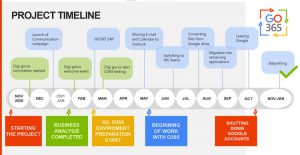
GO365 project timeline
Business assessment (1st phase of migration to Microsoft 365: December 2020 to January 2021)
We didn't come to build on a greenfield site. So before we started renovating, we needed to find out
- which cooperation procedures in the CS worked well,
- which Google Workspace tools there was satisfaction,
- what the workers would needed to improve.
We therefore started the GO365 project with an intensive survey of many of the bank's employees - across departments and different levels of management. The success of the migration to Microsoft 365 depended on the satisfaction of CS employees with the resulting change.
Based on 68 guided interviews and an understanding of business needs, the most significant benefits of the planned change were:
- Outlook as an essential tool for communication, calendar and contact management and room booking,
- MS Teams as a single communication platform,
- one document format stored on a shared drive with a classic directory structure
- and desktop applications Office 365 with advanced features.
Implementation of the M365 environment (Phase 2: February-April 2021)
Process Implementation included the purchase of licenses, installation of applications and certificates, numerous registrations, and the tedious work of setting up security. It was mostly a routine phase that we don't have to dwell on. It wasn't until the next one that it started to get hot.
Migration to Microsoft 365 (Phases 3-6: May-October 2021)
We have divided the main migration phase of the project into four packs:
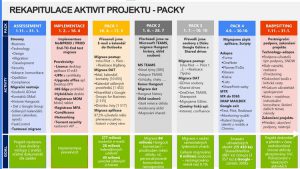
GO365 project phases
Pack 1: emails and calendar
After the pilot migrations came the first sharp migration weekend. We were about to be relocated 277 million emails, 28 million calendar events and 40 million shared mailbox items from Gmail to Outlook.
The result? After 40 hours of concentrated work by a team of 78 people (and an unexpected plot twist starring New Zealand - see box below), all the history had been transferred 97.5 % users (the rest followed afterwards).
The main change (which users often don't even notice) was a new way of sorting mail - instead of labeling, it is now sort emails into folders.
30 hours instead of 10 minutes
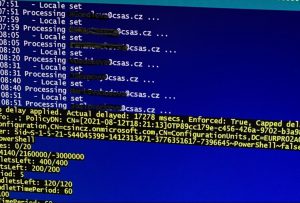
Each newly established mailbox had regional settings in English. Therefore, around 4 pm on Friday, we launched all 13,000 mailboxes change regional settings to Czech.
If you run an operation that takes only a few milliseconds thirteen thousand times, you expect it to be done in ten minutes. But maintaining, backing up or deploying new versions of the M365 takes place in the early hours of Oceania - up to several hours at a time.
First, the hotline in Canada hung up on us.
Around 8 p.m. we opened an incident on Microsoft Category A.
Support from India contacted us around 9:00 and relieved us with about five operators. Around midnight we sent most of the team to sleep (except for four hardy guys).
Between 3am and 4am we managed to change the regional settings for 12(!) mailboxes.
At 7 o'clock, the whole team was back in the office and tensely watched the change of settings all day. We arrived on Saturday at 10 p.m. - after 30 hours.
Pack 2: Hangout & File Cleanup
How many conversations will 13,000 users produce in seven years? In the case of the CS section of decent 84 million. And every single one of them went from Hangouts to Teams. While on the original platform users were quite busy searching for information, the structured Teams environment is much more user-friendly in this respect.
As the 3rd pack approached and with it the crucial file migration (moving), our communication with the bank gained momentum.
What does the packaging entail?
When you're moving, the first thing you do is... - PackagingExactly. You usually follow a few rules:
- You only pack what makes sense to move, the rest you throw away.
- Pack things in boxes so that they don't get damaged.
- You describe the boxes and organise the move so that the boxes end up at the right address and in the right rooms.
You don't want to be looking for clothes in a box of (broken) dishes.
We used the word "pack" to communicate cleaningbecause the files on my private and Google drives were... in short, a mess. A mess that stemmed from a very Google's flexible file storage principle.
Until now, users could create a space where they could share files with each other and the team, virtually anywhere. Google made these files labels, and each file can have multiple labels. Some of them may also have a meaning directory/folderso that a single file "lies" in multiple places at the same time.
Isn't it confusing? You bet it is.

File handling plans - G Suite vs. O365
Custom-made tools helped us a lot with the preparation and implementation of the move:
- Thanks to the app Tracker we could see if the files were still in their original location or if the owner had already moved them to a suitable location for migration.
- Tool Mapper assisted users with "ordering" where to move files from for them, and then confirmed the resulting destination.
Then there was the Scanner, Locker, Translator and Spammer, which we'll get to in a moment.
Pack 3: Google files
Technologically, the biggest challenge of the GO365 project was convert the addressless structure of 8 million files from Google Drive and Shared Drives (with many labels) into a hierarchical structure Teams and drives on SharePoint and OneDrive.
How is the migration tool supposed to know who owns a particular file? Which location should it migrate it to? Should it make as many copies as there are labels?
Useful tools in action again
Let's simplistically imagine file migration as moving books from a child's bookshelf. If we mindlessly pack them in a box that we label with the word BOOKS (they are books, after all), the contents of the box may end up in the new bookcase in the living room, where we don't want them, and on the contrary, there is a desperate search for them in the children's room on the first evening.
That's why our tools came up again:
- The question of file ownership was solved by the tool Scanner. It found the main owner of the file, to whose repository the file then went (i.e. to the right shelf in the children's library).
- What happened when a user clicked on a link to an already migrated file in an older email? Then the tool was activated Translatorwhich redirected users from the original Google Workplace environment to the same file in the new M365 environment.
- Tool The lock locked each migrated file and notified the user that it was about to open the migrated file. We took advantage of the synergy with Translator and show you where the file you're looking for is located.
- We had a tool in reserve Spammerwhich... It doesn't really matter, we didn't have to use it after all.
Pack 3 was implemented in seven separate weekly waves. It's as if we migrated one year of the bank's life every week. In the end, only 0.1 % of the original files did not migrate - the remaining millions successfully settled at the new address in M365 on the expected date.
Pack 4: other applications, scripts and identity deletion
We have concluded the migration phase of the GO365 project by Google Workspace has been shut down:
- 15 430 user identities,
- 881 shared mailboxes,
- 3 357 Hangout groups
and as of October 31, 2021, we are separated CS and Google Workspace definitely cut off.
The emphasis has shifted from the technical level of the project to the area of adoption, i.e. online training and intensive communication with all users (under the patronage of AUTOCONT). Overall, the migration process to Microsoft 365 included:
- 900 Digi Guru on board (Digi Guru = a CS worker able and willing to help colleagues with adoption),
- 6 Let's GO - live broadcasts from the studio for 1000-1500 viewers,
- 15+ SPOC meetings,
- 4,000 subscribers to the live information broadcast in one day via Teams,
- 140 online training courses for users,
- 400+ instructions, procedures, change cards, interactive guides,
- 2900+ answers to user questions in a moderated group on Teams,
- 500+ frequently asked questions and answers in the FAQ app.

The first live studio broadcast of Let's GO was watched by 3,000 users at once.
Babysitting (last phase of migration to Microsoft 365: November 2021 to January 2022)
The closing of the Microsoft 365 migration project was in the spirit of supporting the adoption of the new working environment, as we mentioned above. We dealt with user comments, answered questions, and worked out the last kinks.
We also collected ideas for operational support and finetuning of the M365 environment user satisfaction survey. Interesting conclusions emerged:
- Employees who joined during 2021 are most satisfied with the transition to M365.
- The least satisfied employees are those who have only worked with Google tools at CS so far.
- CS head office employees have been using M365 tools for the longest time and rate them very favourably, which should eventually be transferred to the branch network.
- The greatest user satisfaction is with the Teams app.
- The least user satisfaction is with the overall friendliness of the M365 environment, with the speed of loading and searching.
The process of collecting data related to user satisfaction continues even after the end of the project.
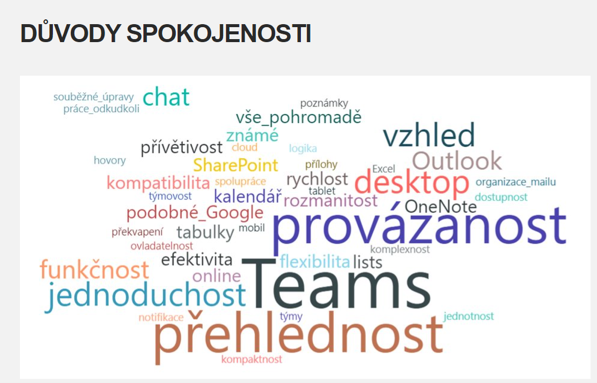
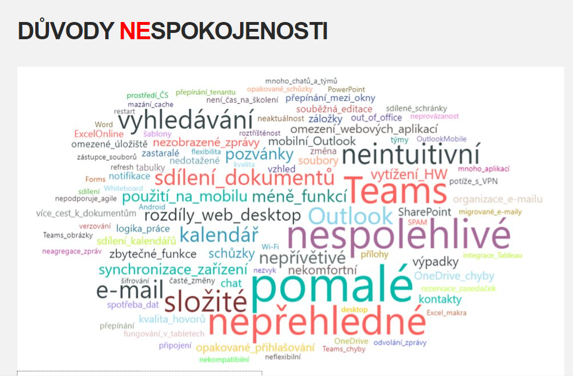
Reasons for user satisfaction/dissatisfaction with migration before project completion
Lessons learned from the Microsoft 365 migration project
In managing such a large-scale project, we have they could not rely on rigid procedures. Unplanned circumstances and unexpected situations required experience and good judgement on the part of ORBIT and CS to ensure that the decisions taken did not delay the original plan.
That there was still room for improvement? Undoubtedly:
- We originally planned to migrate the files in one wave. Unreal. We needed to give people time to clean up and blow it up (also because of the holidays).
- It's good to think that X people may migrate during migration. rename. Experimentally verified
- Project Management does not equal delivery management. Or, project management has rules that must be followed, which tends to conflict with the ability to deliver quickly or move forward quickly.
- Before the project started, we they did not insist on the nomination of all necessary competences and roles on the CS side. Because of this inconsistency, we had to work more than was demanded (especially in the areas of coordination of internal CS teams or testing).
- Two more words: New Zealand.
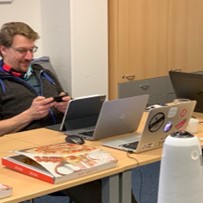
The number of devices you have, the number of times you're a dad.
The GO365 project 241 people were directly involved and ORBIT delivered what it promised:
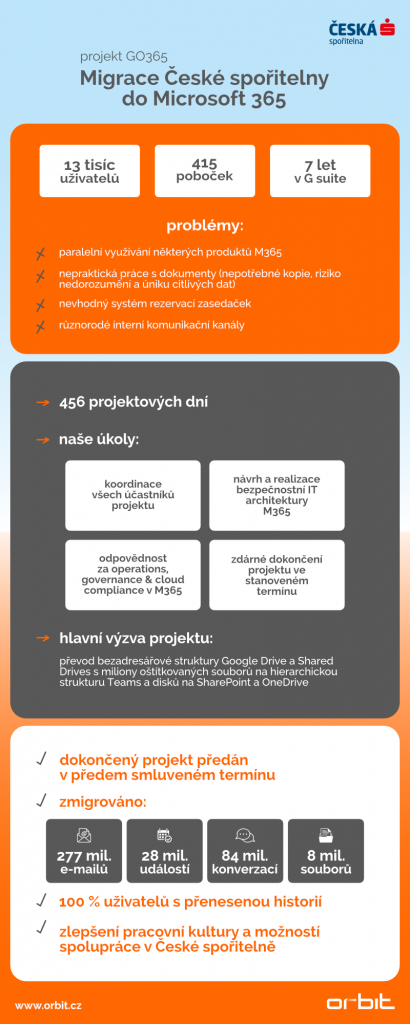
What's next for us? We are not absolving ourselves of responsibility. Follow-up activities, several ongoing line projects and continuous monitoring of user suggestions keep us on our toes to Microsoft 365 environment helped Česká spořitelna in achieving its business objectives.




